Last year’s United Nations Climate Change Conference (“COP26”) didn’t achieve as much as many people had hoped, but one of the agreements hammered out during the event gave Taiwan’s government an opportunity to brag.
On Nov. 2, the EU and the US jointly launched the Global Methane Pledge. Countries that sign up to the accord — to date, 110 have done so — are committed to a collective effort to reduce global methane emissions by at least 30 percent from 2020 levels by the end of this decade.
This is an important step, because methane is the number two greenhouse gas (GHG) driving climate change. It isn’t clear if global methane emissions have grown since the onset of the pandemic, yet a New York Times report of Jul. 14, 2020 quoted scientists as saying that, while they had some hopes that anthropogenic carbon dioxide emissions won’t increase by much, they had no reason to think that humanity was anywhere near “peak methane.”
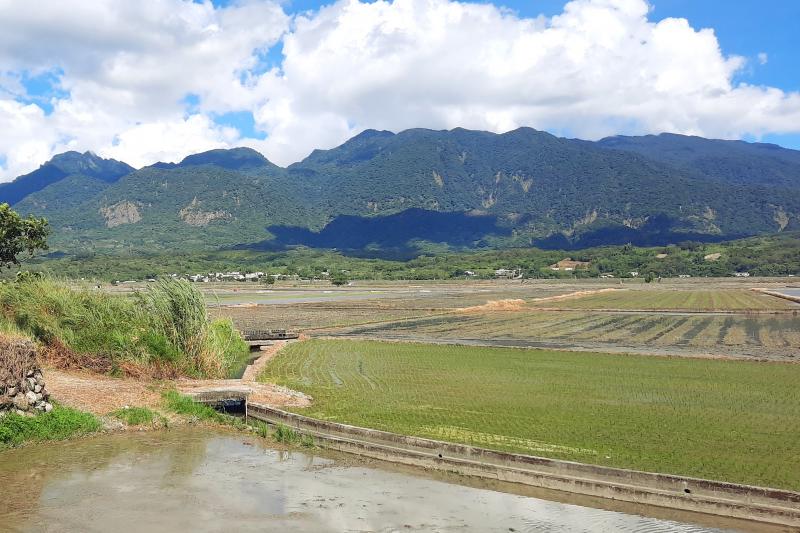
Photo: Steven Crook
Tonne for tonne, methane traps far more heat than carbon dioxide. Fortunately, it doesn’t persist for so long. According to the World Resources Institute, carbon dioxide is responsible for about three quarters of the global warming caused by GHG emissions; the relatively small amount of methane humankind adds to the atmosphere contributes 17.3 percent; while the impact of nitrous oxide (emitted by agriculture, fossil-fuel combustion and certain industrial processes) is calculated to be 6.2 percent.
SLASHED EMISSIONS
Just after the Global Methane Pledge was announced, Major Environmental Policies, a digital monthly published by the Environmental Protection Administration’s (EPA) Office of Sustainable Development, pointed out that Taiwan has already slashed its methane emissions, the 2019 total being just half of 2005’s.
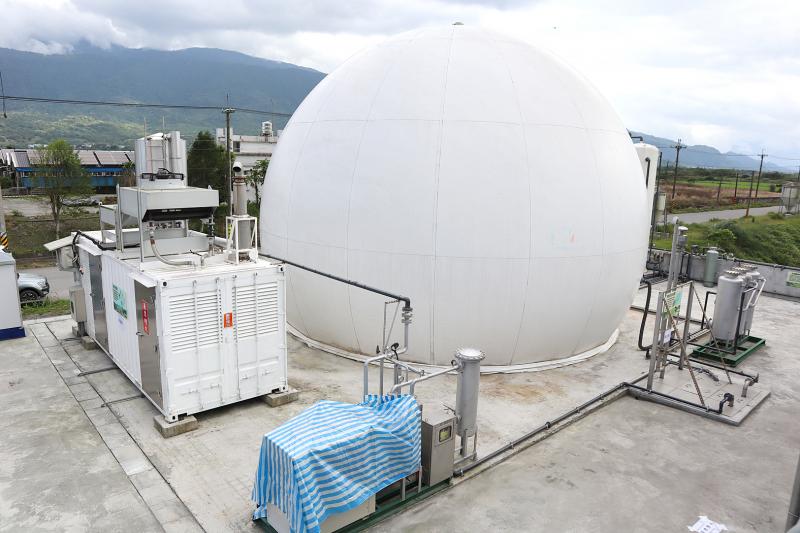
Photo: CNA
If anything, comparing numbers from 2019 with those from 2005 understates the progress Taiwan has made. According to a Mar. 13, 2013 presentation, given by an EPA official and posted online by the Global Methane Initiative, emissions in 2010 were just one eighth of those in 1998 — the year in which Taiwan’s methane emissions likely peaked.
Major Environmental Policies attributed the fall in methane emissions to better handling of municipal waste and proper disposal of biogas (methane and other gases produced by the fermentation of organic matter).
In much of the world, landfills are major sources of biogas, often in such quantities that it can be exploited to generate electricity. One of Asia’s largest landfill-gas power projects was inaugurated at Sicingpu (西青埔) in Kaohsiung in May 2000. It still produces electricity, but — because no trash has been added to the site since 1999 — in smaller amounts than a decade ago.
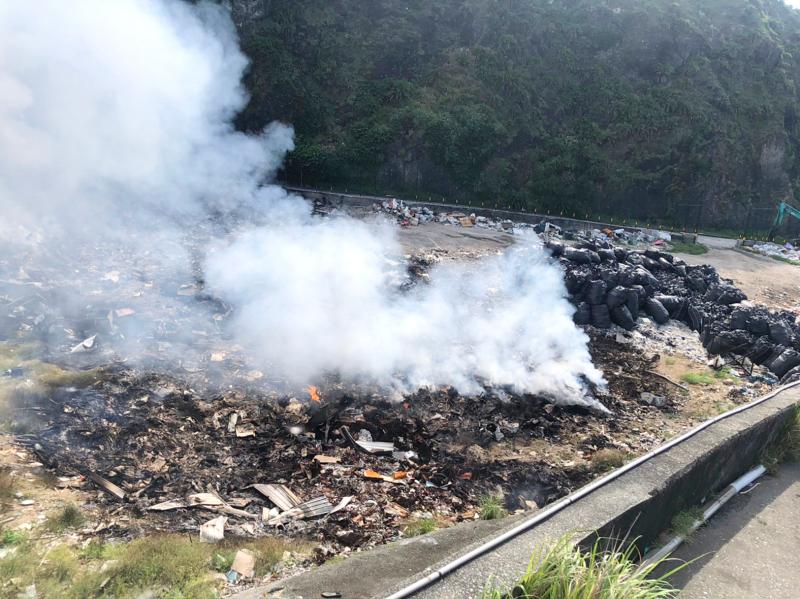
Photo courtesy of the Taitung Fire Department
The importance of managing methane emissions from garbage is made obvious by numbers highlighted in the 2013 EPA presentation.
By the late 1990s, solid waste landfills were responsible for at least 85 percent of the methane Taiwan sent skyward. Most of the remainder was generated by agriculture, especially livestock farming. Since then, if official data is accurate, the country seems to have reduced emissions from landfills to a negligible amount.
Pigs and chickens emit far less methane than ruminant animals such as cattle and goats. However, their excrement — when broken down by bacteria — is a major source of the gas. (Taiwan has far more people than pigs, but the direct release of methane from human bodies, in form of breath and flatus, isn’t significant; that said, such emissions are expected to increase as the human population grows older and heavier. Studies on the environmental impact of human excrement focus more on its potential use as manure or for electricity production, than on its being a source of atmospheric methane.)
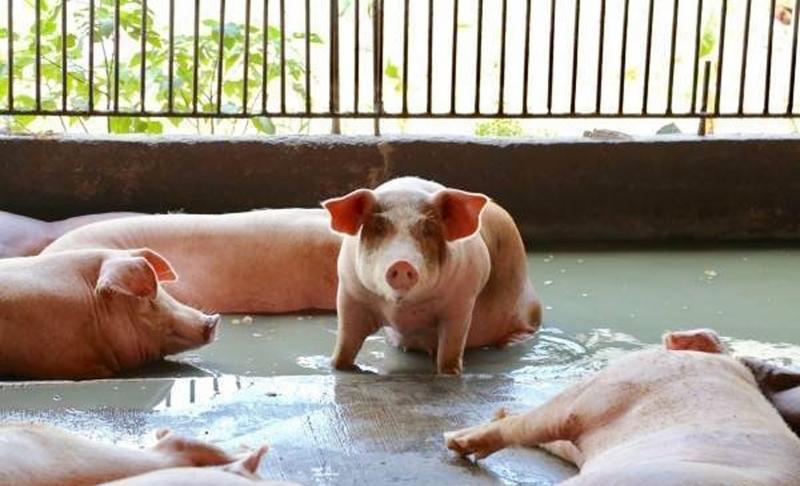
Photo: Yang Yuan-ting, Taipei Times
BIOGAS PRODUCTION
According to Council of Agriculture statistics, by the end of 2017, waste from more than 1.4 million pigs was being used to produce biogas, which was then burned to produce electricity. That number reached 2.5 million in 2020.
Taiwan Sugar Corp (Taisugar) is rebuilding 13 of its largest piggeries so that swine are raised in a fully-enclosed environment. In addition to allowing more efficient use of their urine and excrement, this reduces odors that might upset nearby residents. As a state-owned enterprise, Taisugar has to follow the government’s renewable energy and circular economy policies; the new piggeries are also being fitted with photovoltaic panels.
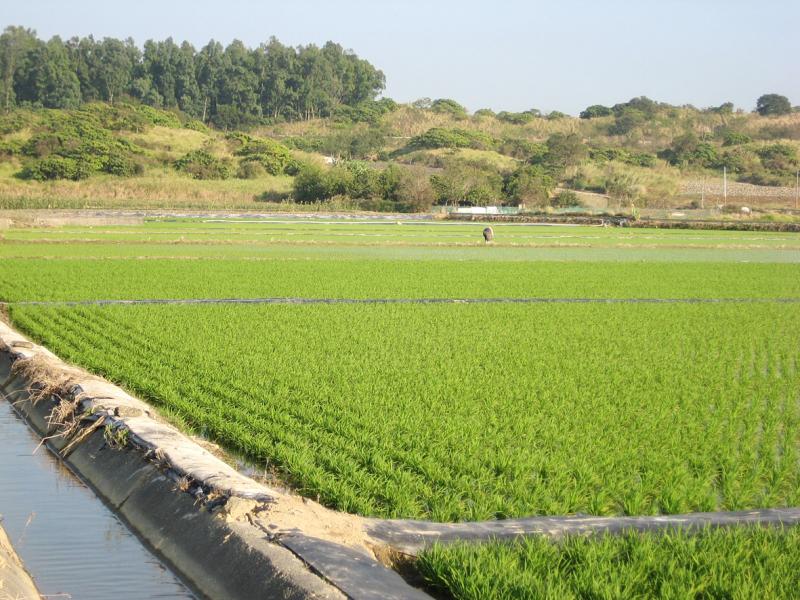
Photo: Steven Crook
Nowadays, more than a quarter of Taiwan’s methane comes from the country’s rice fields. An article in the April 2020 issue of Wired explains why: “Rice is usually grown in water, and there’s not much oxygen in the muddy bottom of a rice paddy. That low-oxygen muck is a happy place for a type of bacteria that produces methane.”
Taiwanese scientists have found that altering water levels can reduce the amount of methane rice fields emit. The Wired article focuses on an entirely different response: Researchers in California discovered that introducing certain fish species to paddies changes the water’s bacterial makeup, cutting methane emissions by up to 64 percent.
A METHANE DROP IN THE GHG OCEAN
According to EPA figures, about 90 percent of Taiwan’s GHG emissions (in terms of warming impact) are carbon dioxide, with a mere 1.67 percent being methane.
There are two main reasons why, compared with other countries, methane is such a tiny component of Taiwan’s overall emissions: There’s no significant extraction of fossil fuels (methane leaks are a feature of oil and LPG production), and the nation has few cattle.
Yet, despite the government’s push for renewable energy, Taiwan still relies on fossil fuels to keep the lights on and cars moving. Also, Taiwanese have a growing appetite for beef and dairy products.
Almost 100 percent of the coal and natural gas burned in Taiwan’s power stations is imported, as is over 95 percent of the beef that’s eaten here. In other words, we’re externalizing our methane emissions.
Hung Shen-han (洪申翰) a Democratic Progressive Party (DPP) lawmaker and environmental activist, recognizes this. He has called on the Ministry of Economic Affairs (MOEA) and CPC Corporation, Taiwan to use their leverage as major purchasers of natural gas and prioritize procurement from companies that minimize leakages.
According to a Radio Taiwan International online report on Nov. 22 last year, when asked to respond to COP26’s Global Methane Pledge by the Legislative Yuan’s Economics Committee, Minister of Economic Affairs Wang Mei-hua (王美花) said that Taiwan obtains most of its natural gas through medium and long-term contracts, implying that there’s little room to switch suppliers. She reiterated that the fuel is a critical “bridging energy source” for Taiwan as it moves toward a non-nuclear future, and stressed that “on the issue of reducing GHG, everybody has a responsibility.”
She’s right, of course. Taiwan has tamed the beast of methane — but the country shouldn’t waste time on self-congratulation until the dragon of carbon dioxide emissions has been slain.
Steven Crook, the author or co-author of four books about Taiwan, has been following environmental issues since he arrived in the country in 1991. He drives a hybrid and carries his own chopsticks. The views expressed here are his own.

June 2 to June 8 Taiwan’s woodcutters believe that if they see even one speck of red in their cooked rice, no matter how small, an accident is going to happen. Peng Chin-tian (彭錦田) swears that this has proven to be true at every stop during his decades-long career in the logging industry. Along with mining, timber harvesting was once considered the most dangerous profession in Taiwan. Not only were mishaps common during all stages of processing, it was difficult to transport the injured to get medical treatment. Many died during the arduous journey. Peng recounts some of his accidents in

Taiwan Power Co (Taipower, 台電) and the New Taipei City Government in May last year agreed to allow the activation of a spent fuel storage facility for the Jinshan Nuclear Power Plant in Shihmen District (石門). The deal ended eleven years of legal wrangling. According to the Taipower announcement, the city government engaged in repeated delays, failing to approve water and soil conservation plans. Taipower said at the time that plans for another dry storage facility for the Guosheng Nuclear Power Plant in New Taipei City’s Wanli District (萬里) remained stuck in legal limbo. Later that year an agreement was reached
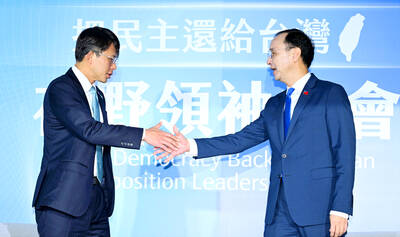
What does the Taiwan People’s Party (TPP) in the Huang Kuo-chang (黃國昌) era stand for? What sets it apart from their allies, the Chinese Nationalist Party (KMT)? With some shifts in tone and emphasis, the KMT’s stances have not changed significantly since the late 2000s and the era of former president Ma Ying-jeou (馬英九). The Democratic Progressive Party’s (DPP) current platform formed in the mid-2010s under the guidance of Tsai Ing-wen (蔡英文), and current President William Lai (賴清德) campaigned on continuity. Though their ideological stances may be a bit stale, they have the advantage of being broadly understood by the voters.
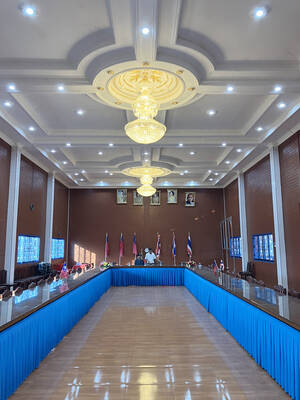
In a high-rise office building in Taipei’s government district, the primary agency for maintaining links to Thailand’s 108 Yunnan villages — which are home to a population of around 200,000 descendants of the Chinese Nationalist Party (KMT) armies stranded in Thailand following the Chinese Civil War — is the Overseas Community Affairs Council (OCAC). Established in China in 1926, the OCAC was born of a mandate to support Chinese education, culture and economic development in far flung Chinese diaspora communities, which, especially in southeast Asia, had underwritten the military insurgencies against the Qing Dynasty that led to the founding of